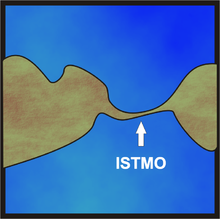Earthcache é simples: Visitar o local, Ler a página do cache, Responder as perguntas para o owner (não no log) e então Registrar... Qualquer dúvida entre em contato
Earthcache is simple: Visit the site, Read the cache page, Answer the questions for the owner (not in the log) and then Register... Any questions please contact us
A ponte que une o Boi à Tartaruga (zoônimos dos acidentes geográficos locais)
A Ilha das Tartarugas, localizada no balneário de Caiobá, é um sítio arqueológico tombado pelo IPHAN desde 1989. Pois nessa ilha se encontram vestígios do homem Sambaqui,considerado um dos primeiros habitantes da região.
Pode ser visitada por um fácil acesso, seguindo o istmo pelas pedras e chegando até uma trilha que leva a uma torre e o outro lado, onde a vista é linda com um visual do outro lado do mar.
Esta travessia pode ocasionar uma infeliz surpresa, pois em horários alternados a maré sobe e cobre a passagem natural, podendo deixar um desavisado preso na ilha.
Istmo é uma estreita faixa de terra, um acidente geográfico que une duas áreas de território. permitindo que as duas extensões diferenciadas se mantenham em contato. Neste sentido, um istmo pode unir duas ilhas, duas massas continentais e uma península com um continente. Pode possuir comprimento variado, neste nosso exemplo ele une a ilha ao continente.
Apenas para uma imagem mental, o inverso do istmo (que localiza-se entre duas massas de água e conecta duas grandes massas terrestres) seria um estreito (que fica entre duas massas terrestres e ligam duas grandes massas de água.
A palavra é de origem grega, isthmos significa pescoço. Nome dado pelos gregos antigos à pequena tira que separa do continente europeu a região sul daquele país, chamada Peloponeso, que mais tarde viria a ser conhecida como istmo de Corinto.
Posteriormente a palavra passou a designar todas as ligações de península com terra firme e, mesmo a ligação entre dois continentes, como nos casos dos istmos do Suez e do Panamá. Em alguns desses locais foram construídos canais de navegação que possibilitam aos navios passarem de um para outro mar ou oceano, sem necessidade de percorrerem grandes distâncias.
A formação dos istmos tem sido atribuída a diversas causas. Uma delas seria pela erosão marinha, tendendo então tais istmos a desaparecerem, como desapareceram os de Bering, que ligava a Ásia ao continente americano, o de Gibraltar, entre a África e a Europa, e de Calais, no estreito de Dover, canal da Mancha, que separa a França da Inglaterra. Frequentemente, porém, eles seriam devidos a fraturas incompletas em regiões vulcânicas, considerando-se dessa forma os istmos do Panamá e de Corinto.

O detalhe importante para compreender a formação e comportamento ao longo do tempo (evolução do relevo), é que foi ocorrido de acordo com dois tipos de processos: endógenos e exógenos.
Os processos endógenos estão ligados à dinâmica interna da Terra ou dinâmica da litosfera (tectonismo, magmatismo, metamorfismo, orogênese e epirogênese). Estes processos modificam a posição altimétrica e a orientação das vertentes preexistentes. Dessa forma, são os processos endógenos então, os responsáveis pela construção do relevo.
Os exógenos são responsáveis por moldá-lo. Estes tipos de processos estão ligados à dinâmica externa da Terra (Atmosfera e superfície terrestre). Exemplos deste são o intemperismo, a ação pluvial, a ação eólica, ação do gelo, ação biológica e antrópica, entre outros.
Os processos endógenos constroem o relevo, os exógenos são responsáveis por moldá-lo.
A “Geomorfologia de encostas” é o ramo que estuda a atividade em sopés (base) de morros e montanhas, como os movimentos de massa (deslizamentos) e manutenção de encostas.
Devido posição e dos tipos de sedimentos sugere-se que os blocos neste istmo são originarios da vertente convexa do Morro do Boi, moldado pelo movimento das águas marinhas e também por interferência antrópica (relativo à ação do homem)
O morro do Boi, assim como os demais morros da baixada litorânea, são constituídos por gnaisses e migmatitos de idades pré cambrianas, inferiores à 550 milhões de anos. Estas rochas estão cortadas por diques de diabásio com idades de 130 milhões de anos, originados durante
a abertura do Oceano Atlântico Sul.
Se você visitou este local e leu corretamente a descrição PODE FAZER O LOG no Earthcache, envie as respostas via mensagem, se elas porventura NÃO estiverem corretas eu entrarei em contato
Questões: